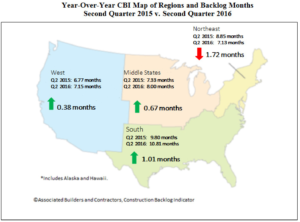Construction Backlog Indicator Shows Overall Dip
9/24/2016 | Construction Blog
The Construction Backlog Indicator, or CBI, is a tool that measures backlog as an indicator of the health of the construction industry. The CBI is presently offering mixed signals to the market. While multi-national and large construction firms are showing the largest backlogs in history, this seems to correspond with a decrease in backlog for medium sized and small contractors.
Companies with annual revenue above $100 million have now reached a zenith of 14.06 months average backlog, surpassing the previous quarterly high of 12.23 months. With a dip for small construction companies, the overall CBI measure is down to 8.5 months nationally from 10.1 months in the first quarter of 2016.
Non-residential backlog growth, which has led the recovery in the construction economy, seems to be slowing overall. The problem appears linked to all the public money spent as part of the governmental stimulus packages. This money allowed larger contractors, particularly in infrastructure work, to gain more market share quickly. Smaller contractors received some of the trickle-down effect of this spending. Now that money has dried up and the larger contractors are maintaining the same market share without sharing as much of the available revenue.
 The northeast region has been hit harder than most. A splurge in construction backlog over the course of the last couple years was related to increased activity that has now slowed as a glut of office space has been put on the market. Of the 4 major regions measured, the northeast is the only one to lose ground in the CBI.
The northeast region has been hit harder than most. A splurge in construction backlog over the course of the last couple years was related to increased activity that has now slowed as a glut of office space has been put on the market. Of the 4 major regions measured, the northeast is the only one to lose ground in the CBI.
It seems unlikely that much will change, for the good or the bad, in the third or fourth quarter. With a pending presidential election, the government and companies traditionally sit on the sidelines until the next president is chosen. The construction industry, like most others, will likely maintain the status quo and then make an adjustment based on who wins.
